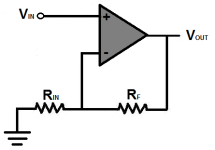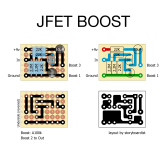dubspecialist
New member
OK so I have a somewhat theoretical question to pose for anyone that is willing to help me. I am a n00b when it comes to this stuff so please forgive any glaringly obvious gaps in my knowledge. I am looking at the final two op amp gain stages in the Arachnid circuit and wondering if it could be possible to mod this for a pot controlled fuzz at the output stage of this circuit... I understand these two stages are 'inverting' gain stages and I assume that this is because stage 3 is a 'volume' control and op amp 'law' tells us "a disadvantage using non-inverting opamps is that they can’t have a gain less than 1, meaning that they can’t attenuate the signal" - hence the use of the inverting input at this stage and again at unity gain stage 4 to invert back (or am I mistaken?). I appreciate that through the use of diodes and a resistor (pot) we could achieve a fuzz circuit on this inverting gain stage in the arachnid BUT my problem is this... it seems the type of 'fuzz' or overdrive that I like is 'no clipping' or no diode boost/fuzz/overdrive (whatever you want to call it). I know this because I love the 'fuzz' sound on the DBA Echo dream 2 and the Plumes when set to mode 2 (pump the gain knob, reduce the level knob).
OK, long-winded I know, my question is this - could it be possible to change stage 3 and 4 of the Arachnid circuit to non-inverting and implement a no-diode drive with pot-control gain stage at one of these that felt akin to the 'fuzz' stage within the echo dream 2 or does the 3.3v power pose a problem here (lack of headroom / noisey maybe)? I have attached schematics for the arachnid and the ED2 for convenience. Any assistance would be greatly appreciated and apologies if I sound like a nincompoop.
OK, long-winded I know, my question is this - could it be possible to change stage 3 and 4 of the Arachnid circuit to non-inverting and implement a no-diode drive with pot-control gain stage at one of these that felt akin to the 'fuzz' stage within the echo dream 2 or does the 3.3v power pose a problem here (lack of headroom / noisey maybe)? I have attached schematics for the arachnid and the ED2 for convenience. Any assistance would be greatly appreciated and apologies if I sound like a nincompoop.





